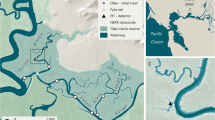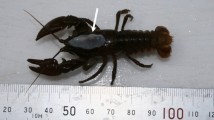Abstract
Signal crayfish (Pacifastacus leniusculus) are an invasive species of global significance because of their detrimental impacts on freshwater environments and native organisms. The movement of signal crayfish was continuously monitored for 150-days through a 20-m reach of an alluvial stream in the UK. Passive integrated transponder-tags were attached to crayfish, allowing their location to be monitored relative to 16 antennae which were buried beneath the river bed. The activity of crayfish was related to water depth and temperature, which were continuously monitored within the instrumented reach. Crayfish were highly nocturnal, with less than 6% of movements recorded during daylight hours. Activity declined from September and was minimal in November when water temperature was low and flow depth was high. However, relations between environmental parameters and crayfish activity had poor explanatory power which may partly reflect biological processes not accounted for in this study. Water depth and temperature had a limiting relationship with crayfish activity, quantified using quantile regression. The results extend existing data on signal crayfish nocturnalism and demonstrate that, although signal crayfish can tolerate a range of flows, activity becomes limited as water temperature declines seasonally and when water depth remains high in autumn and winter months.








Similar content being viewed by others
References
Almeida, D., A. Ellis, J. England & G. H. Copp, 2013. Time-series analysis of native and non-native crayfish dynamics in the Thames River Basin (south-eastern England). Aquatic Conservation: Marine and Freshwater Ecosystems. Early view. doi:10.1002/aqc.2366.
Basil, J. & D. Sandeman, 2000. Crayfish (Cherax destructor) use tactile cues to detect and learn topographical changes in their environment. Ethology 106: 247–259.
Bubb, D. H., M. C. Lucas & T. J. Thom, 2002. Winter movements and activity of signal crayfish Pacifastacus leniusculus in an upland river, determined by radio telemetry. Hydrobiologia 483: 111–119.
Bubb, D. H., T. J. Thom & M. C. Lucas, 2004. Movement and dispersal of the invasive signal crayfish Pacifastacus leniusculus in upland rivers. Freshwater Biology 49: 357–368.
Bubb, D. H., T. J. Thom & M. C. Lucas, 2006. Movement patterns of the invasive signal crayfish determined by PIT telemetry. Canadian Journal of Zoology 84: 1202–1209.
Cade, B. S. & B. R. Noon, 2003. A gentle introduction to quantile regression for ecologists. Frontiers in Ecology and the Environment 1: 412–420.
Crawford, L., W. E. Yeomans & C. E. Adams, 2006. The impact of introduced signal crayfish Pacifastacus leniusculus on stream invertebrate communities. Aquatic Conservation: Marine and Freshwater Ecosystems 16: 611–621.
Frissell, C. A., W. J. Liss, C. E. Warren & M. D. Hurley, 1986. A hierarchical framework for stream habitat classification: viewing streams in a watershed context. Environmental Management 10: 199–214.
Gherardi, F., S. Barbaresi & F. Villanelli, 1998. Movement patterns of the white-clawed crayfish Austropotamobius pallipes, in a Tuscan Stream. Journal of Freshwater Ecology 134: 413–424.
Gherardi, F., S. Barbaresi & G. Salvi, 2000. Spatial and temporal patterns in the movement of Procambarus clarkii, an invasive crayfish. Aquatic Science 62: 179–193.
Gherardi, F., E. Tricarico & M. Iljeu, 2002. Movement patterns of the invasive crayfish, Procambarus clarkii, in a temporary stream of southern Portugal. Ethology, Ecology and Evolution 14: 183–197.
Gherardi, F., S. Barbaresi & G. Salvi, 2006. Spatial and temporal patterns in the movement of Procambarus clarkii, an invasive species. Aquatic Sciences 62: 179–193.
Gibbins, J. W. & K. M. Andrews, 2004. PIT tagging: simple technology at its best. Bioscience 54: 447–454.
Guan, R.-Z., 1994. Burrowing behaviour of signal crayfish, Pacifastacus leniusculus (Dana), in the River Great Ouse, England. Freshwater Forum 4: 155–168.
Guan, R.-Z. & P. R. Wiles, 1997. Ecological impact of introduced crayfish on benthic fishes in a British lowland river. Conservation Biology 11: 641–647.
Guan, R.-Z. & P. R. Wiles, 1998. Feeding ecology of the signal crayfish Pacifastacus leniusculus in a British lowland river. Aquaculture 169: 177–193.
Harvey, G., T. P. Moorhouse, N. J. Clifford, A. Henshaw, M. F. Johnson, D. W. MacDonald, I. Reid & S. P. Rice, 2011. Evaluating the role of invasive aquatic species as drivers of fine sediment-related river management problems: the case of the signal crayfish (Pacifastacus leniusculus). Progress in Physical Geography 35: 517–533.
Harvey, G., A. Henshaw, T. Moorhouse, N. Clifford, H. Holah, J. Grey & D. MacDonald, in press. Signal crayfish as drivers of fine sediment dynamics in rivers: field and laboratory evidence. Earth Surface Processes and Landforms.
Holdich, D. M., W. D. Rogers & J. D. Reynolds, 1999. Native and alien crayfish in the British Isles. In Gherardi, F. & D. M. Holdich (eds), Crayfish in Europe as Alien Species: How to Make the Best of a Bad Situation?. A.A. Balkema, Rotterdam: 221–236.
Johnson, M. F., S. P. Rice & I. Reid, 2010. Topographic disturbance of subaqueous gravel substrates by signal crayfish (Pacifastacus leniusculus). Geomorphology 123: 269–278.
Johnson, M. F., S. P. Rice & I. Reid, 2011. Increase in coarse sediment transport associated with disturbance of gravel river beds by signal crayfish (Pacifastacus leniusculus). Earth Surface Processes and Landforms 36: 1680–1692.
Kirjavainen, J. & K. Westman, 1999. Natural history and development of the introduced signal crayfish, Pacifastacus leniusculus, in a small, isolated Finnish lake, from 1968 to 1993. Aquatic Living Resources 12: 387–401.
Koch, L. M., B. W. Patullo & D. L. Macmillan, 2006. Exploring with damaged antennae: do crayfish compensate for injuries? The Journal of Experimental Biology 209: 3226–3233.
Koenker, R., 2012. Quantile regression in R: A vignette. http://cran.r-project.org/web/packages/quantreg/vignettes/rq.pdf (accessed March 2013).
Lancaster, J. & L. R. Belyea, 2006. Defining the limits to local density: alternative views of abundance-environment relationships. Freshwater Biology 51: 783–796.
Light, T., 2003. Success and failure in a lotic crayfish invasion: the roles of hydrologic variability and habitat alteration. Freshwater Biology 48: 1886–1897.
Lodge, D. M., R. A. Stein, K. M. Brown, A. P. Covich, C. Brönmark, J. E. Garvey & S. P. Klosiewski, 1998. Predicting impact of freshwater exotic species on native biodiversity: challenges in spatial scaling. Australian Journal of Ecology 23: 53–67.
Machino, Y. & D. M. Holdich, 2005. Distribution of crayfish in Europe and adjacent countries: updates and comments. Freshwater Crayfish 15: 292–323.
Momot, W. T., 1966. Upstream movement of crayfish in an intermittent Oklahoma stream. American Midland Naturalist 75: 150–159.
Momot, W. T., 1995. Redefining the role of crayfish in aquatic ecosystems. Reviews in Fisheries Science 3: 33–63.
Nyström, P., 2005. Non-lethal predator effects on the performance of a native and an exotic crayfish species. Freshwater Biology 50: 1938–1949.
Nyström, P. & J. A. Strand, 1996. Grazing by a native and an exotic crayfish on aquatic macrophytes. Freshwater Biology 36: 673–682.
Nyström, P., C. Brönmark & W. Granéli, 1996. Patterns in benthic food webs: a role for omnivorous crayfish? Freshwater Biology 36: 631–646.
Parkyn, S. M. & K. J. Collier, 2004. Interaction of press and pulse disturbance on crayfish populations: flood impacts in pasture and forest streams. Hydrobiolgia 527: 113–124.
Robinson, C. A., T. J. Thom & M. C. Lucas, 2000. Ranging behaviour of a large freshwater invertebrate, the white-clawed crayfish Austropotamobius pallipes. Freshwater Biology 44: 509–521.
Royo, F., G. Gonzalez-Cienfuegos & J. L. Muzguiz, 2002. Preliminary observation of occasional mortality in the population of freshwater crayfish in the Picos de Europa (Asturias, Spain). Bulletin Francais de la Pêche et de la Pisciculture 367: 935–941.
Schofield, K. A., C. M. Pringle, J. L. Meyer & A. B. Sutherland, 2001. The importance of crayfish in the breakdown of rhododendron leaf litter. Freshwater Biology 46: 1191–1204.
Schütze, S., H. Stein & O. Born, 1999. Radio telemetry observations on migration and activity patterns of restocked noble crayfish Astacus astacus (L.) in the small river Sempt, North-East of Munich. Germany. Freshwater Crayfish 12: 688–695.
Stenroth, P. & P. Nyström, 2003. Exotic crayfish in a brown water stream: effects on juvenile trout, invertebrates and algae. Freshwater Biology 48: 466–475.
Usio, N., M. Konishi & S. Nakano, 2001. Species displacement between an introduced and a ‘vulnerable’ crayfish: the role of aggressive interactions and shelter competition. Biological Invasions 3: 179–185.
Vorburger, C. & G. Ribi, 1999. Aggression and competition for shelter between a native and an introduced crayfish in Europe. Freshwater Biology 42: 111–119.
Acknowledgments
We would like to thank Kevin Wallis for allowing us to use the field site; Paul Wood for his help throughout this project; Stuart Ashby and Barry Kenny for help with equipment; and Mary Johnson, Richard Gravelle, Tom Worrell and Andrew Pledger for help with field work. During this study, MFJ was in receipt of a Loughborough University Postgraduate Studentship.
Author information
Authors and Affiliations
Corresponding author
Additional information
Handling editor: Sonja Stendera
Rights and permissions
About this article
Cite this article
Johnson, M.F., Rice, S.P. & Reid, I. The activity of signal crayfish (Pacifastacus leniusculus) in relation to thermal and hydraulic dynamics of an alluvial stream, UK. Hydrobiologia 724, 41–54 (2014). https://doi.org/10.1007/s10750-013-1708-1
Received:
Revised:
Accepted:
Published:
Issue Date:
DOI: https://doi.org/10.1007/s10750-013-1708-1




